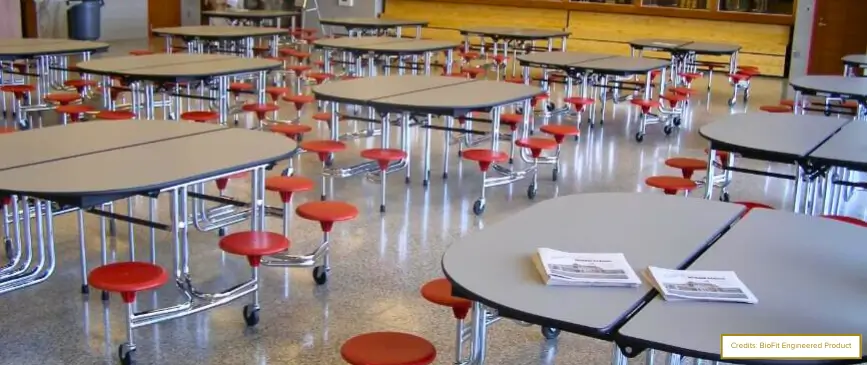Introduction
Are you considering a fresh approach to school lunches? We appreciate your interest!
The impact of school cafeterias on students’ minds, health, and overall well-being is undeniable. Students who enjoy a balanced, nutritious diet with high-quality, freshly prepared meals are far more likely to stay alert in and off classes. However, it’s not just about the food; the setting where they eat can be just as impactful as the food itself.

Outdoor school cafeterias present an exciting alternative to traditional indoor settings. Research indicates that outdoor dining can enhance mood, reduce stress, and even boost concentration by up to 30% compared to indoor dining.
Establishing an outdoor school cafeteria is a fantastic option if you want your students to enjoy more fulfilling lunchtimes.
With over 15 years of experience in cafeteria solutions, we’re here to guide you through this transition. For personalized assistance, reach out to us at Ingenious Culinary Concepts. Meanwhile, let’s explore the essential logistics of setting up an outdoor school cafeteria.
What Is An Outdoor School Cafeteria?
At first glance, it might seem like an outdoor school cafeteria is just a synonym for an indoor one, but the differences go far beyond just location. An outdoor cafeteria doesn’t just differ in its setting but in its overall design and ambiance.
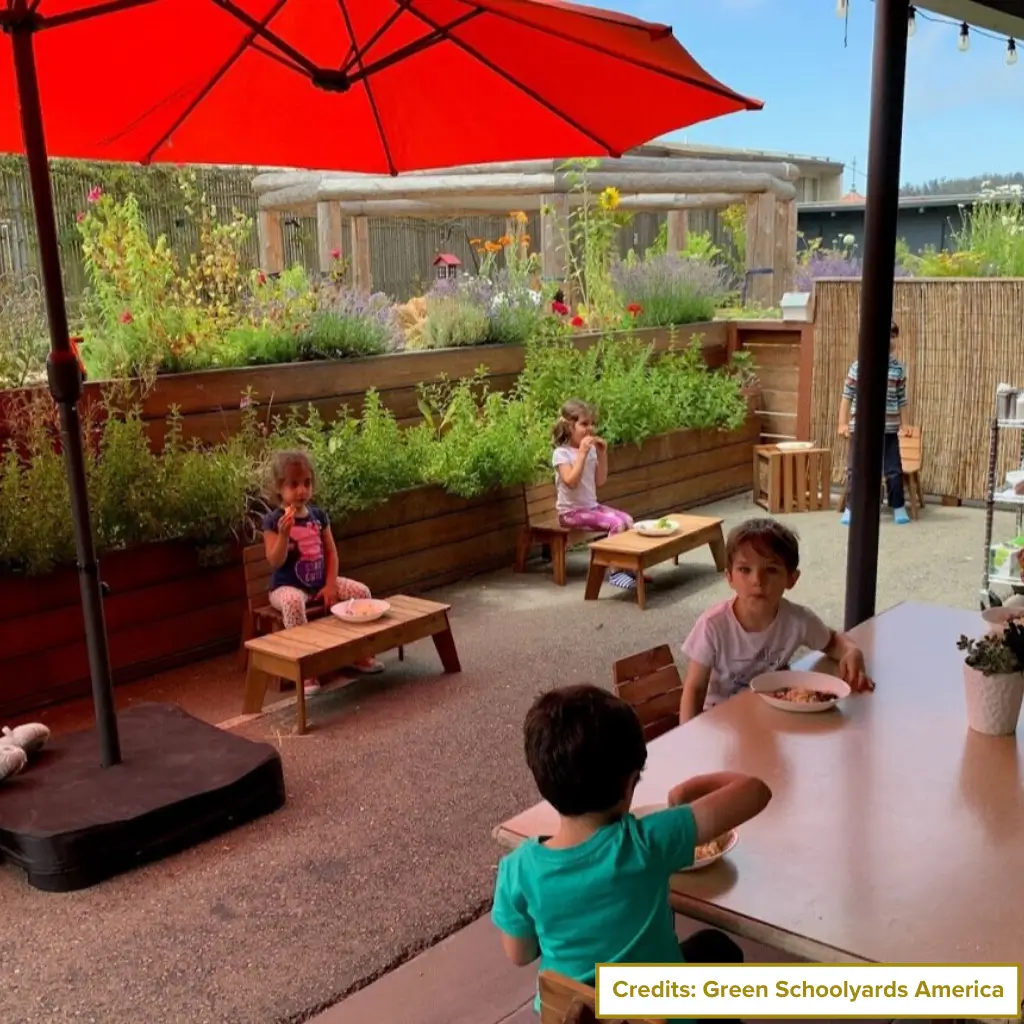
Simply put, an outdoor school cafeteria is a dining space situated in a school’s garden, courtyard, or playground. It provides students with a fresh-air dining experience. Think picnic tables, benches, or other seating arrangements where students can enjoy their meals surrounded by nature.
The lunch menu options remain as nutritious as those of indoor cafeterias, but the setting encourages more than healthy eating. These cafeterias often align with schools focusing on environmental education and outdoor activities, promoting healthier lifestyles and more significant social interactions.
Benefits Of Having An Outdoor School Cafeteria
Modern school cafeterias are evolving to embrace outdoor dining spaces, and the benefits are plenty. Here are just a few:
- Eases Crowding: Adding an outdoor cafeteria means more room for students, reducing long lines and congestion in indoor spaces.
- Improves Lunch Experience: With extra space, students can eat without feeling rushed, creating a more relaxed and enjoyable mealtime.
- Flexible Seating Options: Schools can designate outdoor spaces for different grade levels and rotate their use to give everyone a chance to enjoy outdoor lunches.
- Increases Dining Capacity: More seating areas mean more students can be served, which is especially helpful in schools with growing enrollment.
- Cost-Effective Solution: Outdoor canopies are quicker and cheaper to install than constructing new indoor dining halls, making them a practical solution for schools on a budget.
- Versatile Use: Outdoor school cafeterias can double as teaching spaces during other parts of the day, maximizing their utility.
- Support for Cafeteria Workers: Many outdoor cafeterias partner with catering trucks, allowing cafeteria staff to serve healthier, fresher meals on-site.
- Encourages Outdoor Learning: Covered outdoor areas offer a safe, sun-protected space for learning, enhancing the student experience.
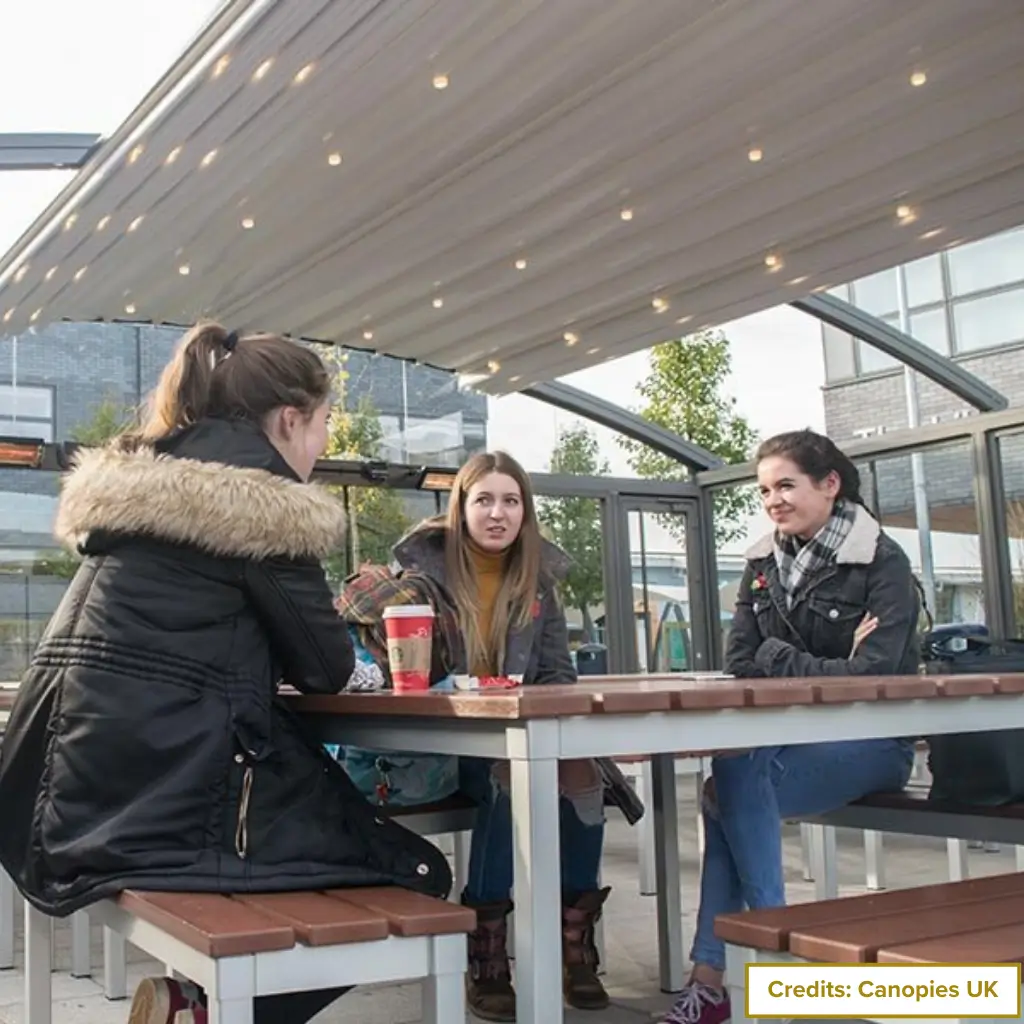
Designing The Perfect Outdoor School Cafeteria – The Key Considerations
A school cafeteria plays a crucial role in student life, and creating the perfect outdoor school cafeteria requires careful thought and expert design. Whether you’re renovating or building from scratch, this is an area where cafeteria renovation experts and school management place great focus.
At ICC, our seasoned pro, Kern Hall has brought his vision to life in various schools. Below are the key elements from his book to consider when setting up an outdoor cafeteria that will engage, inspire, and delight your students.
Space Analysis
Start by assessing the available space. How many students will the cafeteria serve at one time? Allow roughly 1.5 to 2.0 square meters per student to avoid overcrowding. For example, 400 students would require approximately 1,800 to 2,400 square meters. Proper space analysis ensures a comfortable and efficient dining experience.
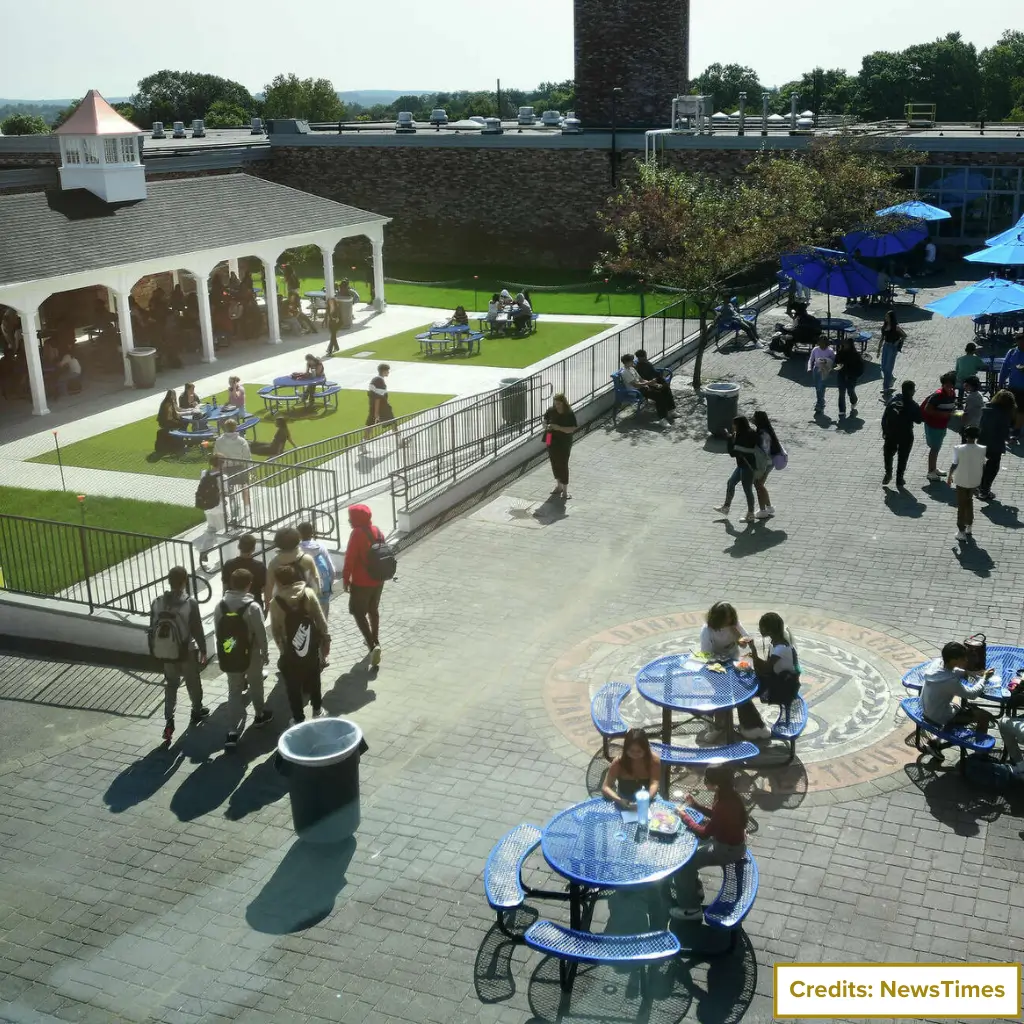
Layout and Design
A well-thought-out layout is critical to functionality and enjoyment. If setting up an elementary school cafeteria, use different types of tables to cater to various seating preferences, such as picnic-style tables and smaller round-edge tables. Clearly define areas for food counters, hand-washing stations, and waste bins to keep the space organized.
Include bulletin boards for sharing important school news and allocate space for unique seasonal cafeteria decorations like Christmas or Halloween to keep the environment festive and engaging. Ensure the layout allows smooth traffic flow to minimize congestion and enhance the dining experience.
Weather Considerations
Design the cafeteria to be functional year-round. Protective elements like canopies, pergolas, or umbrellas will shield students from the sun and rain. During colder months, space heaters or windbreakers can help maintain comfort. Think of using durable, weather-resistant furniture that will last through different seasons.

Accessibility from Classrooms
Easy access to the cafeteria is essential, especially on tight schedules. Pathways should be safe, accessible, and direct from the classrooms. Positioning the cafeteria close to the primary school buildings will allow students to reach it quickly during breaks.
Seating and Student Behavior
Flexible seating options can help manage student behavior and create a comfortable atmosphere. Introduce assigned seating during busier periods to reduce chaos while allowing flexibility at other times. Also, strategic seating layouts should be used to help reduce noise, especially if the cafeteria is near classrooms or quiet areas.
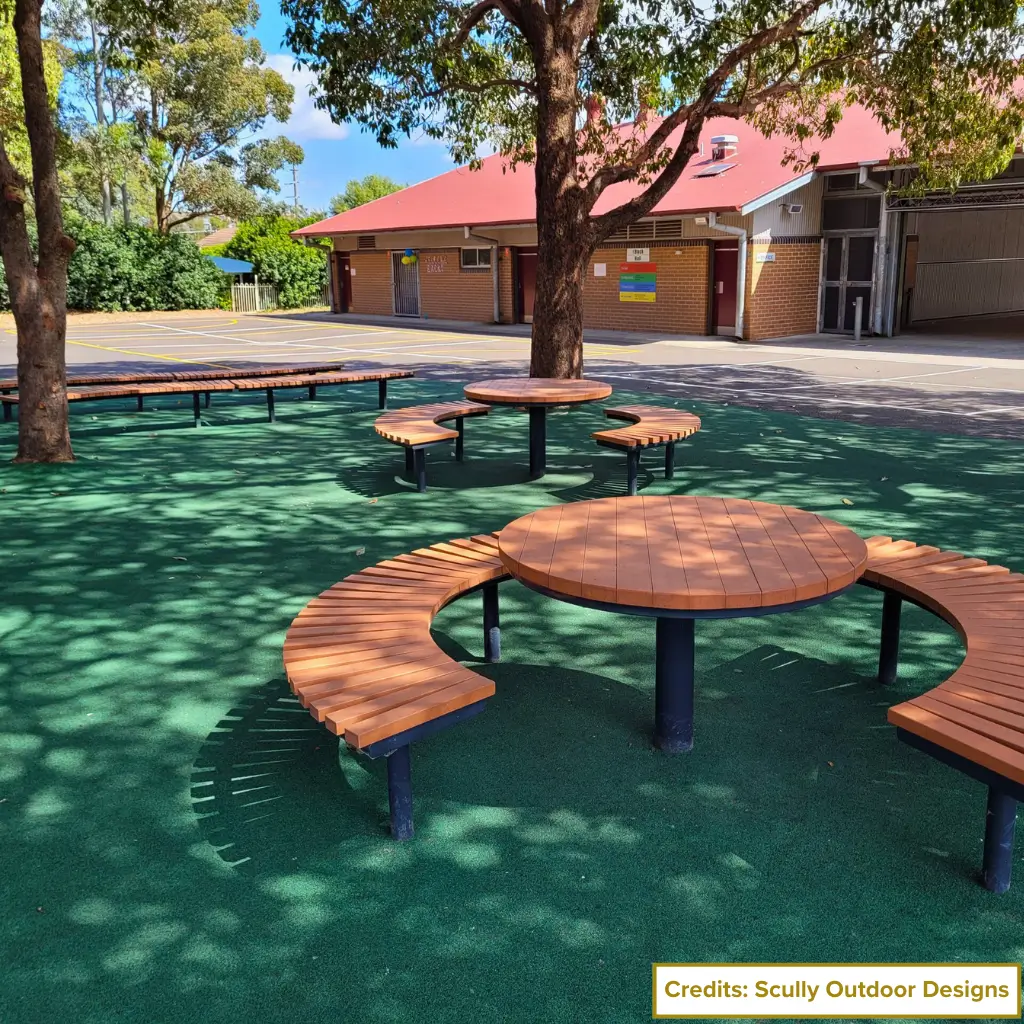
Sustainability and Waste Management
Outdoor school cafeterias offer an excellent opportunity to promote sustainability. Set up recycling and composting stations to manage food waste and educate students on eco-friendly practices. Consider modern approaches like solar-powered lighting and water-saving hand-washing stations to minimize environmental impact and operational costs.
Safety and Security
Safety is paramount. Enclose the space with proper fencing and ensure controlled access to prevent unauthorized entry. Provide adequate supervision through staff or security cameras and ensure clear exit routes and emergency protocols are in place.
Budgeting for Construction
Plan carefully for materials, furniture, and ongoing maintenance to stay within budget. Allocate your resources wisely to ensure a high-quality result without overspending.
Hire Cafeteria Specialists
While having a vision is essential, working with cafeteria design specialists can bring your ideas to life more effectively. They can assist with space optimization, furniture selection, and cost calculations, ensuring your outdoor lunch rooms are functional and visually appealing.
For customized cafeteria services, contact us for tailored solutions. We’ve helped numerous schools design outdoor spaces that students love and are ready to help you.
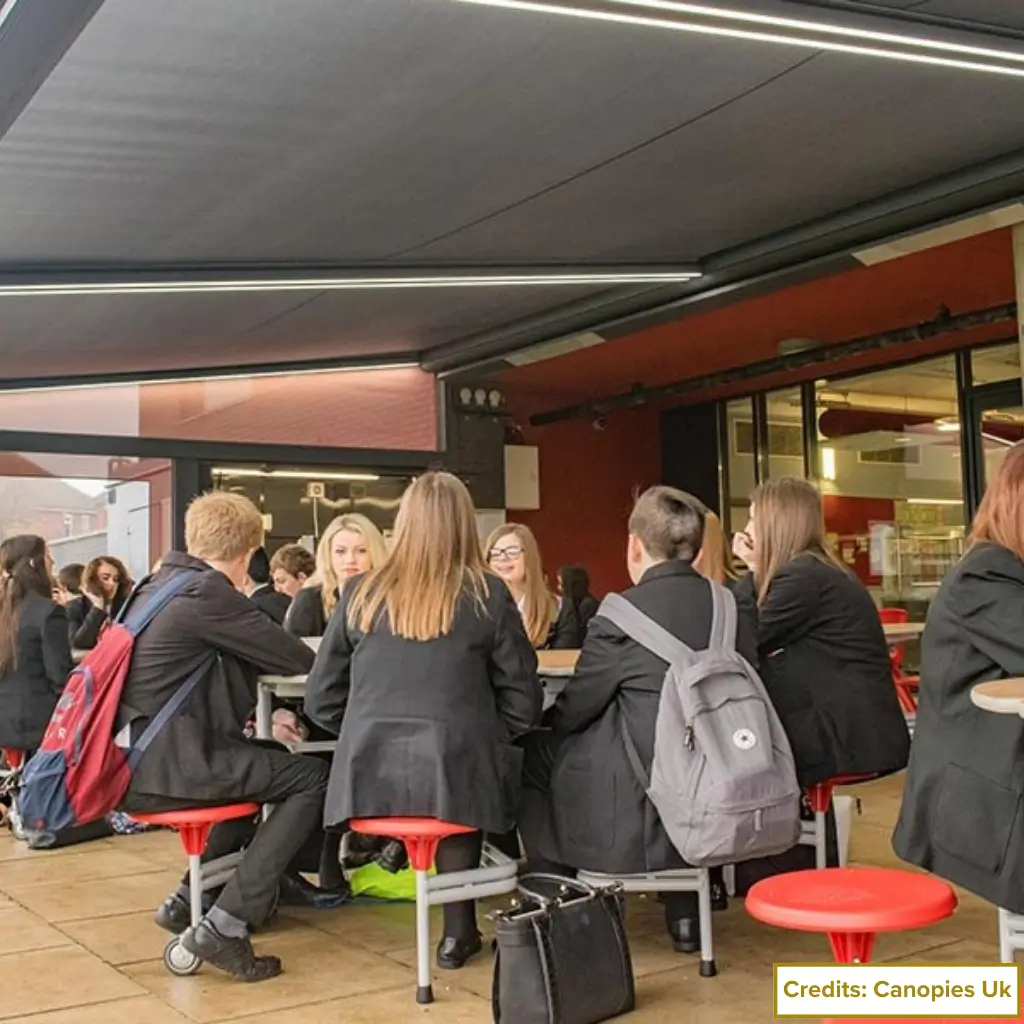
Tips For Successful Outdoor Cafeteria Launch
- Plan a soft opening: Test the space with a small group of students before the official launch to identify any needed adjustments.
- Create excitement: use posters, social media, and school announcements to build anticipation.
- Offer a special menu: include unique or favorite items to draw students in on launch day.
- Set clear guidelines: communicate rules for seating, waste disposal, and food service.
- Involve students: let students participate by decorating the school cafeteria or organizing activities in the new space.
- Train staff to manage the new space efficiently.
- Have backup plans for bad weather, such as alternate indoor seating arrangements.
- Invite parents: inform parents to tour the space during an open house or special event.
- Gather feedback: Perform a school cafeteria survey and ask for student input to fine-tune the experience.
Final Words
In conclusion, an outdoor school cafeteria has so much to offer. It makes lunchtime more fun and engaging. A little creativity can enhance school life, helping students feel good while caring for the environment. After all, it’s not just about opening the doors; it’s about giving kids a fresh way to enjoy their treats and connect with friends.
If you’re curious to learn more or want to see how we can help create the perfect outdoor school cafeteria, don’t hesitate to contact us for customized cafeteria services or visit this link to see our work!
FAQs
Why are outdoor school cafeterias important?
Outdoor school cafeterias create a lively atmosphere where students can socialize and connect with nature. This setting fosters community and contributes to a positive school culture.
What benefits do outdoor cafeterias offer?
Outdoor cafeterias encourage healthy eating by making meals more enjoyable in a fresh-air setting. They can also reduce stress and promote physical activity among students, leading to better overall health.
How can outdoor cafeterias improve lunch attendance?
A pleasant outdoor setting makes lunch more appealing, encouraging students to participate. This increased attendance can contribute to a more vibrant school community.
What should schools consider before building an outdoor cafeteria?
Factors like weather conditions, safety, and available space should be evaluated to ensure success.


